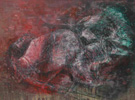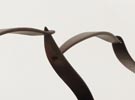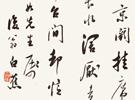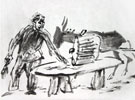Luo Xu
By Barbara Pollack
Reflecting the four seasons, the cycle of life, the latest work by Yunnan artist Luo Xu are leaves—huge bronze leaves—presented not as delicate botanicals, but as monumental forms. These larger-than-life leaves are confrontational and a little intimidating. They grow and wither, but can never blow away, towering over viewers in all of their lifelike appearance.
Luo Xu is unique in the contemporary art scene in China. Born in Mi’le, Yunnan, in 1956, he had to wait more than thirty years to pursue his dream of becoming an artist. His first efforts were recognized by the master-sculptor Qian Shaowu, who encouraged him to enroll at the Central Academy of Fine Art in Beijing. But, just as quickly, Luo Xu realized that to develop his vision he would have to leave the big cities of Beijing or Shanghai, even though these were the places with developing art centers. Instead, he found a piece of land just outside Kunming which he turned into his personal art center. The structures he erected there, now well known as the Earth Nest, are breast-like mounds, some rising high above the ground, in which he houses his studio, galleries, and his home. And even in this place that seems isolated, Luo Xu’s outpost attracts tourists and visitors anxious to see the unique home of this very unique artist.
Likewise, Luo Xu’s art attracts and audience, even though he eschews the themes predominant in contemporary art in China. Instead of exploring consumerism or globalization, this artist comments on change and metamorphosis by dwelling on forms from nature or the body. In this latest series of mammoth leaves, he mergers both interests, making natural forms that exude human qualities. Flown Away, 2005 one of his latest works, evokes a leaf suspended from a tree about to fall or dance away in the wind. It literally looks as if it could spread its wings, like a fairy, but it is terrifying in its scale and the texture of its surface. Winter Still Life, 2005 lies on the floor, a fallen crinkled frond, curled into itself, as if on the brink of death. That these works are as much about mortality as botany is made clear by his very newest creations, such as Last Drop of Honey, 2006 or Acupuncture of Fallen Leaves, 2006 two bronze sculptures that exude the last moment of life or even more poignant, the moment beyond revitalization. These states-of-being may be all part of the life cycle, but they are also phases beyond life that few want to think about or consider.
Luo Xu forces us to see these moments—the moment just before death or the moments just after death—by magnifying not only the size of his leaves, but their expressiveness. These leaves seem in excruciating pain, or are abundantly sad, almost as if they are in mourning for their lives that pass all too soon from spring into fall. Movement of Spring, 2005 combines a leaf and a caterpillar, looking as if it could crawl across the gallery floor. Summer Seaside, 2005 humorously props up two bulbous leaves, like a wealthy couple sitting side-by-side on a beach. These works are quirky, and could be seen as a bit silly, but there is something in the way that Luo Xu develops these sculptures—their textured surfaces and their unaccommodating strength—that makes them too angry and intimidating to be taken as a joke. This is work that evokes the mania and insanity of the early Surrealists, like Salvador Dalí, as well as the latest science fiction films. What mammoth trees could have produced these gigantic leaves? What chaos would ensue if these leaves came to life and took revenge on the humans who have relished their destruction?
In fact, though Luo Xu has been often described as a naïve or a madman, he is actually in tune with the realities of contemporary life in China. Just nearby his compound, in Kunming, he has plenty of examples of the destructiveness of urban development rapidly encroaching on the beauty of the province of Yunnan. In this way, his work could be interpreted as dire warnings against such wanton destruction of the natural world. But, on the other hand, his work basks in the deterioration of nature that comes with the phases of the seasons, where autumn inevitably follows summer, but then winter slowly evolves into spring. It is the success of this work that it could be interpreted on either level—topical or tropical—but in either case, sears the viewer’s mind with unforgettable images.
Surrealism allows an artist to delve deep into his own psyche even as he examines the madness of the world. Luo Xu’s earliest work is the best examples of surrealism. Here, he explored the shape of women’s legs in works that are funny and sexy, ugly and sleek. These shapely thighs and elongated calves end in the pointiness of miniscule feet, as if foot-binding was still a practice in the 21st century. But, Luo Xu reminds us that this distortion of the female form has been a liberty taken by artists since the first sculpture of a woman, the Venus of Willendorf, was created in prehistoric times. In his version, Eastern Venus, No. 2, 2001, using resin and fiberglass instead of bronze, Luo Xu creates a woman as sleek as an automobile’s hood ornament. In Eastern Venus, No. 3, the lower half of the torso practically kicks its streamlined leg into the viewer’s face. These are very provocative views of women, with sexuality blatantly displayed, yet detached from any personality or emotion of real woman. They are forms of pure fantasy. By declaring his right to create (or even imagine) such fantasies, Luo Xu allows his audience to feel free enough to come up with fantasies of their own.
Indeed, in both his life story and his art works, Luo Xu creates a space for personal freedom, which he then offers up as a gift to the rest of the world. He has developed as an artist, quite a bit, from the obsession with women’s legs to the broader metaphor of leaves as a commentary on all of life. His earlier work gave permission to consider sexuality; his later works now confer permission to consider mortality. Neither are issues that necessarily fit into the work ethic or upward mobility of China at the beginning of the 21st century. But, by insisting on his freedom to consider these essential and perennial aspects of life, Luo Xu confers on his viewers the freedom to be madmen or naïves themselves.










